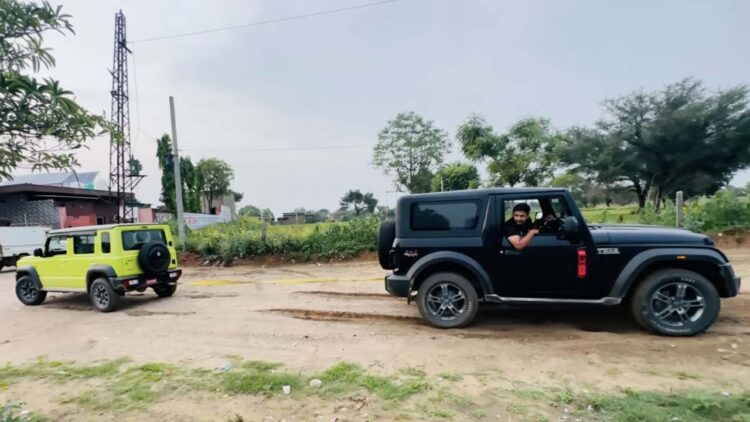In a recent tug of war competition organised between Maruti Jimny and Mahindra Thar, the former gave the latter a run for its money
When it comes to off-road adventures, the Maruti Suzuki Jimny and Mahindra Thar are two great choices in the sub Rs 20 lakh price bracket. However, there’s much to differentiate between the two SUVs. For instance, while one’s a petrol-only model, the other is available in petrol as well as diesel. The Thar, in fact, is even a shoe size bigger and offers more power. Recently, some people organised a classic tug of war match between the two. The results are pretty interesting.
You may also like: Maruti Jimny Owner Explains Why He Cut His Brand New SUV
Mahindra Thar 4×4 Diesel and Maruti Jimny in Tug of War Match
In the first round, the Mahindra Thar easily wins. As per the video host, both the SUVs were in 4×2 mode and you can see how easily the Thar manages to drag the Jimny towards itself. In the next round, the Jimny engages 4×4 High while the Thar stays in 4×2 mode. This time around, the Thar fails to pull the smaller SUV towards itself as it struggles to avoid losing the battle. It even ends up burning a fair bit of rubber during long wheelspins. However, there was no clear winner of this round. Finally, in the last leg, both the SUVs engage 4×4 High. This time around, even though the Jimny just about managed to pull the Thar only a bit towards itself, it was declared the winner. This is because the clutch plates of the Thar started to overheat and the match had to be called off. The Jimny was declared the winner as it could give the more powerful off-roader a run for its money.
You may also like: India’s First Maruti Jimny with 21-inch Alloy Wheels
Specs Comparison
| Maruti Suzuki Jimny | Mahindra Thar Diesel 4×4 |
| 1.5-litre, naturally-aspirated petrol | 2.2-litre, turbocharged diesel |
| 104.8 PS – 134.2 Nm | 118 PS – 300 Nm |
| 5 MT/4 AT | 6 MT/6 AT |
| Kerb Weight – 1195 – 1210 KG | 1750 KG |
| Drive – ALLGRIP Pro with Low Range Transfer Case | Manual Shift Part-time 4×4 with High and Low Reduction Gear |
| Length – 3985 mm | 3985 mm |
| Width – 1645 mm | 1820 mm |
| Height – 1720 mm | 1850 mm |
| Ground Clearance – 210 mm | 226 mm |
Under the hood, the Maruti Suzuki Jimny is equipped with a 1.5L petrol engine, delivering ample power for off-road excursions and sedate on-road driving. Its compact size and lightweight construction provide excellent maneuverability, making it agile on challenging terrains. Meanwhile, the Mahindra Thar 4×4 Diesel packs a punch with its 2.2L diesel engine, offering superior torque and enhanced towing capacity. Its exceptional ground clearance and advanced 4×4 drivetrain ensure exceptional off-road performance. Both the SUVs are available with an optional 6-speed torque converter automatic transmission. However, it’s noteworthy here that the Jimny in question has an automatic transmission and the Thar has a manual unit.
You may also like: Maruti Jimny vs Gypsy Tug of War Shows Shocking Results
Lightweight 4×4 with Lower Power vs More powerful 4×4 with Higher Weight
When it comes to a tug of war competition, the choice between a lightweight 4×4 with less power and a more powerful 4×4 with higher weight depends on various factors. Let’s consider the advantages and disadvantages of each option.
Lightweight 4×4 with Less Power
A lightweight 4×4 vehicle offers certain advantages in a tug of war competition. Due to its lower weight, it can provide better traction on the surface, allowing it to dig in and gain more grip. This can be especially beneficial when the surface is loose or slippery. The lighter weight also puts less strain on the vehicle’s drivetrain components, reducing the risk of mechanical failures during the competition. However, the downside of a lightweight 4×4 with less power is that it may struggle against a heavier and more powerful opponent. It may lack the sheer pulling force needed to overcome the resistance of a heavier vehicle. In such cases, its advantage in traction might not be sufficient to compensate for the power disparity.
More Powerful 4×4 with Higher Weight
A more powerful 4×4 with higher weight can have a significant advantage in a tug of war competition. The additional power generated by a stronger engine allows it to exert greater force and pull the opposing vehicle more effectively. The higher weight of the vehicle provides additional traction, making it harder for the lighter opponent to overcome the resistance. However, the increased weight can also be a disadvantage in certain situations. If the surface is not supportive or if it’s too soft, the heavier vehicle may sink or struggle to maintain traction, reducing its overall pulling force. Additionally, the higher weight puts more strain on the vehicle’s drivetrain, increasing the risk of mechanical failures.
You may also like: Maruti Jimny to Mercedes G63 Conversion Kit Now Available in India!
Conclusion
In a tug of war competition, the outcome depends on multiple factors such as surface conditions, traction, power, and weight. While a lightweight 4×4 with less power can benefit from better traction and reduced strain on components, it might struggle against a heavier and more powerful opponent. On the other hand, a more powerful 4×4 with higher weight can exert greater force but may face challenges on unstable surfaces. Ultimately, the success in a tug of war competition depends on a combination of power, weight, traction, and the specific conditions of the competition.


